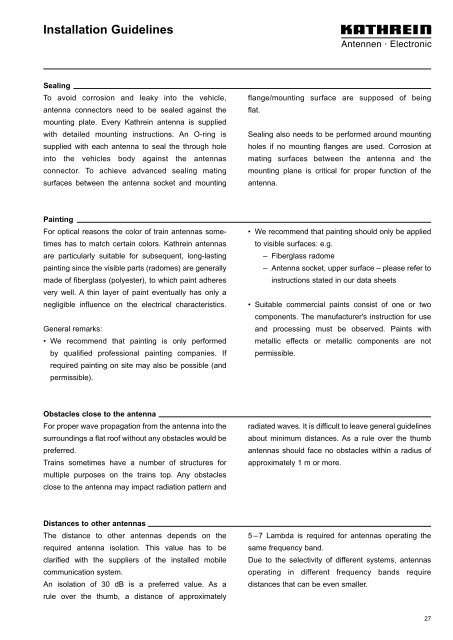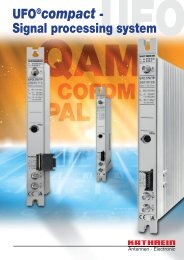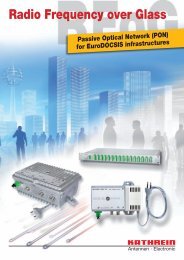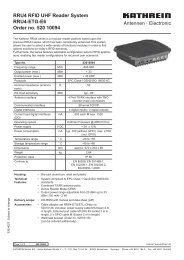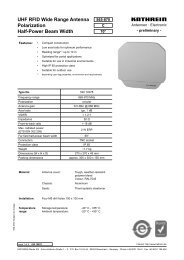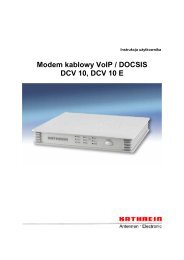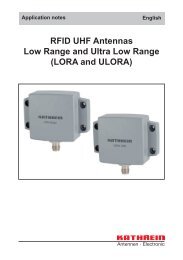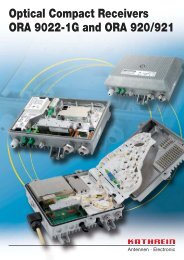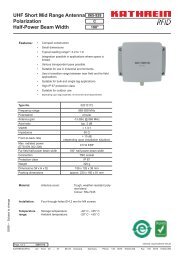Druckschrift 99810265, Antennas for Trains and Buses
Druckschrift 99810265, Antennas for Trains and Buses
Druckschrift 99810265, Antennas for Trains and Buses
Create successful ePaper yourself
Turn your PDF publications into a flip-book with our unique Google optimized e-Paper software.
Installation Guidelines<br />
Sealing<br />
To avoid corrosion <strong>and</strong> leaky into the vehicle,<br />
antenna connectors need to be sealed against the<br />
mounting plate. Every Kathrein antenna is supplied<br />
with detailed mounting instructions. An O-ring is<br />
supplied with each antenna to seal the through hole<br />
into the vehicles body against the antennas<br />
connector. To achieve advanced sealing mating<br />
surfaces between the antenna socket <strong>and</strong> mounting<br />
flange/mounting surface are supposed of being<br />
flat.<br />
Sealing also needs to be per<strong>for</strong>med around mounting<br />
holes if no mounting flanges are used. Corrosion at<br />
mating surfaces between the antenna <strong>and</strong> the<br />
mounting plane is critical <strong>for</strong> proper function of the<br />
antenna.<br />
Painting<br />
For optical reasons the color of train antennas sometimes<br />
has to match certain colors. Kathrein antennas<br />
are particularly suitable <strong>for</strong> subsequent, long-lasting<br />
painting since the visible parts (radomes) are generally<br />
made of fiberglass (polyester), to which paint adheres<br />
very well. A thin layer of paint eventually has only a<br />
negligible influence on the electrical characteristics.<br />
General remarks:<br />
• We recommend that painting is only per<strong>for</strong>med<br />
by qualified professional painting companies. If<br />
required painting on site may also be possible (<strong>and</strong><br />
permissible).<br />
• We recommend that painting should only be applied<br />
to visible surfaces: e.g.<br />
– Fiberglass radome<br />
– Antenna socket, upper surface – please refer to<br />
instructions stated in our data sheets<br />
• Suitable commercial paints consist of one or two<br />
components. The manufacturer's instruction <strong>for</strong> use<br />
<strong>and</strong> processing must be observed. Paints with<br />
metallic effects or metallic components are not<br />
permissible.<br />
Obstacles close to the antenna<br />
For proper wave propagation from the antenna into the<br />
surroundings a flat roof without any obstacles would be<br />
preferred.<br />
<strong>Trains</strong> sometimes have a number of structures <strong>for</strong><br />
multiple purposes on the trains top. Any obstacles<br />
close to the antenna may impact radiation pattern <strong>and</strong><br />
radiated waves. It is difficult to leave general guidelines<br />
about minimum distances. As a rule over the thumb<br />
antennas should face no obstacles within a radius of<br />
approximately 1 m or more.<br />
Distances to other antennas<br />
The distance to other antennas depends on the<br />
required antenna isolation. This value has to be<br />
clarified with the suppliers of the installed mobile<br />
communication system.<br />
An isolation of 30 dB is a preferred value. As a<br />
rule over the thumb, a distance of approximately<br />
5 –7 Lambda is required <strong>for</strong> antennas operating the<br />
same frequency b<strong>and</strong>.<br />
Due to the selectivity of different systems, antennas<br />
operating in different frequency b<strong>and</strong>s require<br />
distances that can be even smaller.<br />
27


